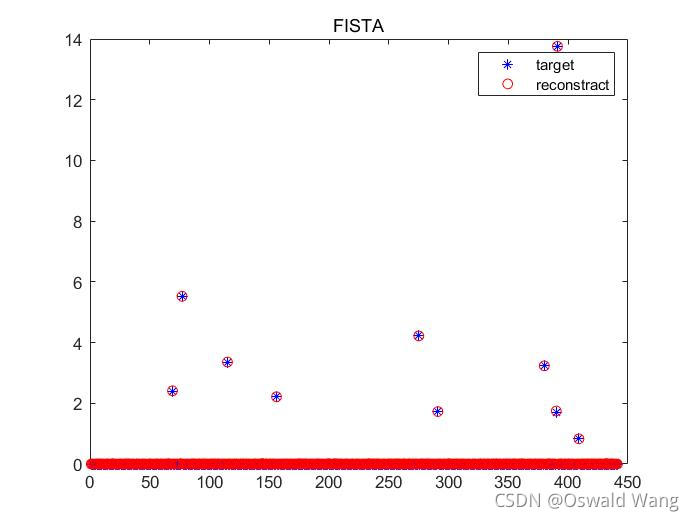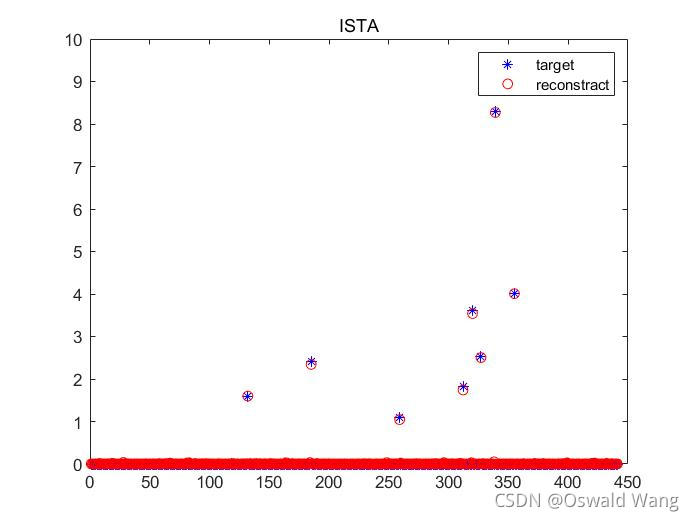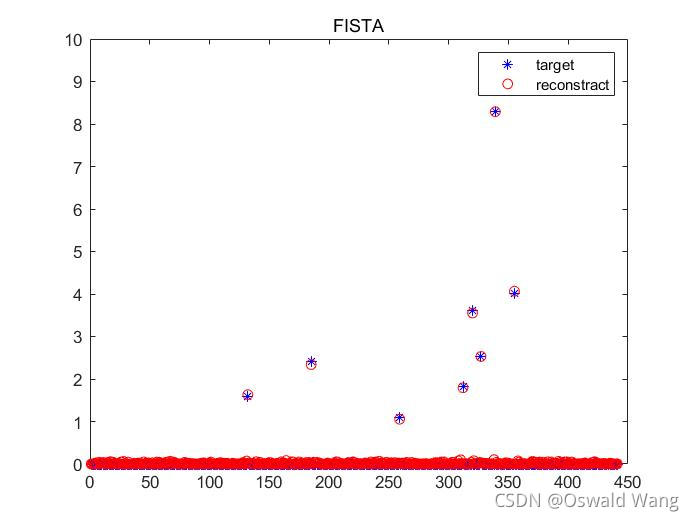软阈值迭代算法(ISTA)和快速软阈值迭代算法(FISTA)
写在前面
软阈值迭代算法(Iterative Soft Thresholding Algorithm, ISTA)和快速软阈值迭代算法(Fast Iterative Soft Thresholding Algorithm, FISTA)是求解线性逆问题的经典方法,属于梯度类算法。FISTA是 Beck [1] 等人在ISTA的基础上改进得来的。
博客"优化与算法"[2]中对算法原理作了简单分析并给出matlab仿真实验。获取文献[1]或阅读英文有困难的,可以看看该博客,不过最好还是看原文献。
对于一个线性系统:y = Ax + w,A是MN的已知观测矩阵,y是N1的已知观测结果,w是加性噪声,x是要求解的源。该问题可以用最小二乘法(Least squares)求解。然而,在大多数条件下A是病态的。当A病态时,最小二乘法就不适用了。因为,系统微小的扰动都会导致结果差别巨大。ISTA和FISTA是求解病态系统的一种有效方法。
MATLAB仿真程序
博主不是数学专业的,数学功底也较为薄弱。因此,本博客不对ISTA和FISTA的原理作过多的解释,以免误人子弟。在仔细阅读了博客"优化与算法"[2]后,博主发现其给出的仿真程序并不完全符合 文献[1] 的理论推导。因此,博主根据自己对 文献[1] 的理解,写了两份程序,来和大家讨论。
固定步长的ISTA
% Iterative Soft Thresholding Algorithm(FISTA)
% written by zhwang @2021-11-13
% Reference: Beck, Amir, and Marc Teboulle. "A fast iterative
% shrinkage-thresholding algorithm for linear inverse problems."
% SIAM journal on imaging sciences 2.1 (2009): 183-202.
% Inputs:
% y - measurement vector
% A - measurement matrix
% lambda - denoiser parameter in the noisy case
% epsilon - error threshold
% iter_max - maximum number of amp iterations
%
% Outputs:
% x_hat - the last estimate
% error - reconstruction error
function [xhat, error] = ISTA(y, A, lambda, epsilon, iter_max)
if nargin < 5
iter_max = 5e3;
elseif nargin < 4
iter_max = 5e3; epsilon = 1e-4;
elseif nargin < 3
iter_max = 5e3; epsilon = 1e-4; lambda = 5e-4;
elseif nargin < 2
iter_max = 5e3; epsilon = 1e-4; lambda = 5e-4;
end
N = size(A, 2); % col of A
errortmp = zeros(iter_max,2);
[~, D] = eig(A'*A);
Lf = 2*max(diag(D)); % A Lipschitz constant of ∇f.
t = 1/Lf;
x0 = zeros(N, 1);
% 开始迭代
for i = 1:iter_max
temp = x0 - 2*t*A'*(A*x0-y);
% A fast iterative shrinkage-thresholding algorithm for linear inverse
% problems 中的方法
x1 = (abs(temp)-lambda*t) .* sign(temp); % 收敛慢
% A Fixed-Point Continuation Method forl1-Regularized Minimization with
% Applications to Compressed Sensing [3] 中的方法
% x1 = max(abs(temp)-lambda*t, 0) .* sign(temp); % 收敛快
errortmp(i,1) = norm(x1 - x0) / norm(x1);
errortmp(i,2) = norm(y - A*x1);
if errortmp(i,1) < epsilon || errortmp(i,2) < epsilon
break
else
x0 = x1;
end
end
xhat = x1;
error = errortmp(1:i,:);
end
固定步长的FISTA
% Fast Iterative Soft Thresholding Algorithm(FISTA)
% written by zhwang @2021-11-13
% Reference: Beck, Amir, and Marc Teboulle. "A fast iterative
% shrinkage-thresholding algorithm for linear inverse problems."
% SIAM journal on imaging sciences 2.1 (2009): 183-202.
% Inputs:
% y - measurement vector
% A - measurement matrix
% lambda - denoiser parameter in the noisy case
% epsilon - error threshold
% iter_max - maximum number of amp iterations
%
% Outputs:
% x_hat - the last estimate
% error - reconstruction error
function [xhat, error] = FISTA(y, A, lambda, epsilon, iter_max)
if nargin < 5
iter_max = 5e3;
elseif nargin < 4
iter_max = 5e3; epsilon = 1e-4;
elseif nargin < 3
iter_max = 5e3; epsilon = 1e-4; lambda = 5e-4;
elseif nargin < 2
iter_max = 5e3; epsilon = 1e-4; lambda = 5e-4;
end
N = size(A, 2); % col of A
errortmp = zeros(iter_max,2);
[~, D] = eig(A'*A);
Lf = 2*max(diag(D)); % A Lipschitz constant of ∇f.
t = 1/Lf;
t1 = 1; %
x0 = zeros(N, 1);
y1 = x0;
% 开始迭代
for i = 1:iter_max
temp = y1 - 2*t*A'*(A*y1-y);
% A fast iterative shrinkage-thresholding algorithm for linear inverse
% problems 中的方法
% x1 = (abs(temp)-lambda*t) .* sign(temp); % 收敛慢
% A Fixed-Point Continuation Method forl1-Regularized Minimization with
% Applications to Compressed Sensing [3] 中的方法
x1 = max(abs(temp)-lambda*t, 0) .* sign(temp); % 收敛快
t2 = 1/2*(1+sqrt(1+4*t1^2));
y2 = x1 + (t1 - 1)/t2 * (x1 - x0);
errortmp(i,1) = norm(y2 - y1) / norm(y2);
errortmp(i,2) = norm(y - A*y2);
if errortmp(i,1) < epsilon || errortmp(i,2) < epsilon
break
else
x0 = x1;
y1 = y2;
t1 = t2;
end
end
xhat = y2;
error = errortmp(1:i,:);
end
测试实例
clear all; clc;
N = 441;
n = 1:N;
M = 289;
K = 10 ;
x = zeros(N,1);
T = 5*randn(K,1); % 实点
% T = 5 * (randn(K,1) + 1i*randn(K,1)); % 复点
index_k = randperm(N);
x(index_k(1:K)) = T;
A = randn(M,N);
y = A * x; % + e
y = awgn(y, 10);
[x_rec1,error1] = ISTA(y,A,5e-0,5e-6,5e3) ;
[x_rec2,error2] = FISTA(y,A,5e-2,5e-5,5e3) ;
%%
figure
plot(1:N,abs(x),'b*',1:N,abs(x_rec1),'ro');
legend('target','reconstract');
title('ISTA');
figure
plot(n, abs(x), 'b*', n, abs(x_rec2), 'ro'); legend('target','reconstract');
title('FISTA');
该测试例程与博客"优化与算法"[2]中的主要不同是:本博客中的观测矩阵A是随机生成的,而[2]中的观测矩阵A的列是正交的。
仿真结果
无噪声时
SNR = 10 dB时
参考文献
[1]: Beck A, Teboulle M. A fast iterative shrinkage-thresholding algorithm for linear inverse problems[J]. SIAM journal on imaging sciences, 2009, 2(1): 183-202.
[2]: https://www.cnblogs.com/louisanu/p/12045861.html
[3]: Hale E T, Yin W, Zhang Y. A fixed-point continuation method for L_1-regularization with application to compressed sensing[R]. 2007.



